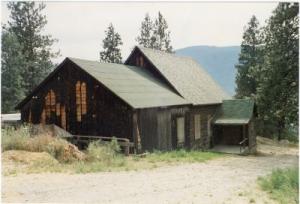The first organized ministry of the Anglican Church began in Okanagan Centre in 1909 with the arrival of Rev. Owen Bulkeley. The Synod of the Dioceses of New Westminster of that same year had reported that two clergymen were needed immediately in the Keremeos and Okanagan districts. Okanagan Centre was chosen as the Okanagan region’s clergy representative base because of its expected growth potential. At the time the Centre was a thriving community, lake boats continuously stopped here on their frequent trips up and down the lake. There was a fairly large fruit industry based around the Rainbow Ranche and the Okanagan Valley Land Company packing house.
The Okanagan Centre “All Saints” Anglican Church construction was started in 1910 under the supervision of Rev. Bulkeley. The cornerstone, which is presently located at Eva Seaton Hall, was laid by Bishop De Pencier in October of 1910.
The Vicar of the Anglican Church parish covered an area which extended from Oyama, to the area known as the Commonage southward to Ellison, which is the present location of the Airport. In addition the Vicar was also responsible to a scattering of small communities across the lake, including Ewing, Caesar and Wilson’s landings. The boundaries as described ran approximately 20 miles east and 21 miles west of Okanagan Lake. It also included service to Woods and Long (Kalamalka) lakes and any settlement in between.
In 1911 Rev. Bulkeley was replaced and by 1912 it was reported by the rural Dean that the parish had 6 to 8 stations on both sides of the lake. The church at Okanagan Centre was ready for flooring and was expected to be in use by that summer. Rev. Robertson expressed concern over the lack of church attendance at the Centre. No reasons or remedies were given for this decline in the numbers of the congregation.
During this same time Rev. A. V. Despard, a retired minister, volunteered his services to the Oyama, Ellison, Okanagan Centre and Winfield areas. He began taking services in the homes of Oyama Anglican parishioners.
By 1913 it was realized by the Synod that the settlement of Okanagan Centre was not growing as expected. The Rural Dean at this time made an application for grant for the completion of the interior of the All Saints Church…. it didn’t arrive….
By the start of World War I there were reports of severe storm damage to the church. In addition, the young men of the congregation were leaving in large numbers to join the military. These two factors, plus that fact that the new highway and railway gave alternate routes of commerce and helped to speed the development of Winfield and Oyama, appear to have led to the decline of the Okanagan Centre church. From 1914 to 1918 there is no mention of the OK Centre church in the Dioceses reports. The church itself was never consecrated and eventually permission was given (1923) to sell the church building. It was turned into the present community hall.”

Source: Fiwcuk, Michelle. The History of the Churches of Lake Country. Challenge Grant 92. Available online at the Lake Country Museum and Archives.
Other materials available online at the Museum are:
Display: Early Churches of Lake Country.
History Index: October 27, 1910 — All Saints Anglican Church
1918 — Oyama United Church
1949 — St. Edward’s Catholic Church
October 31, 2005 — Lake Country United Church







0 Comments